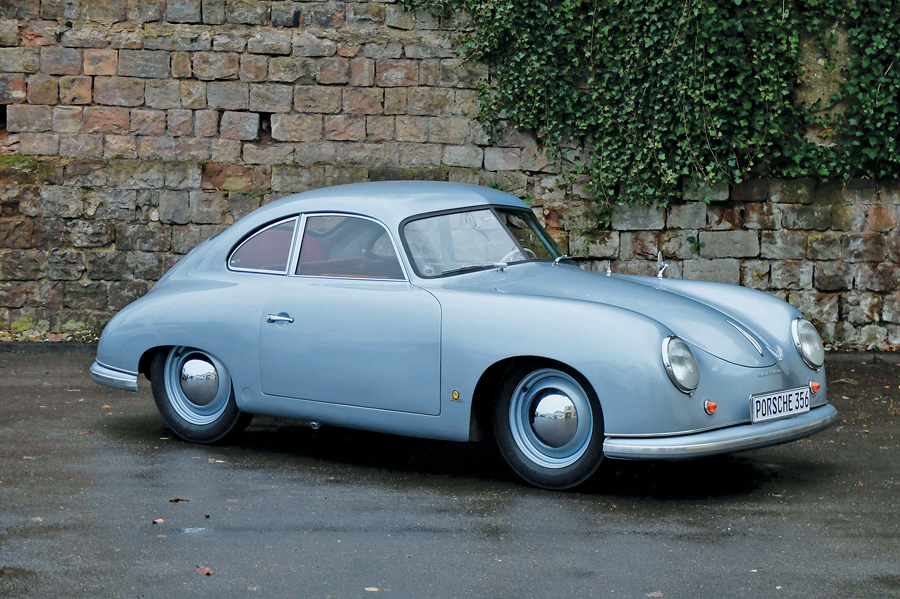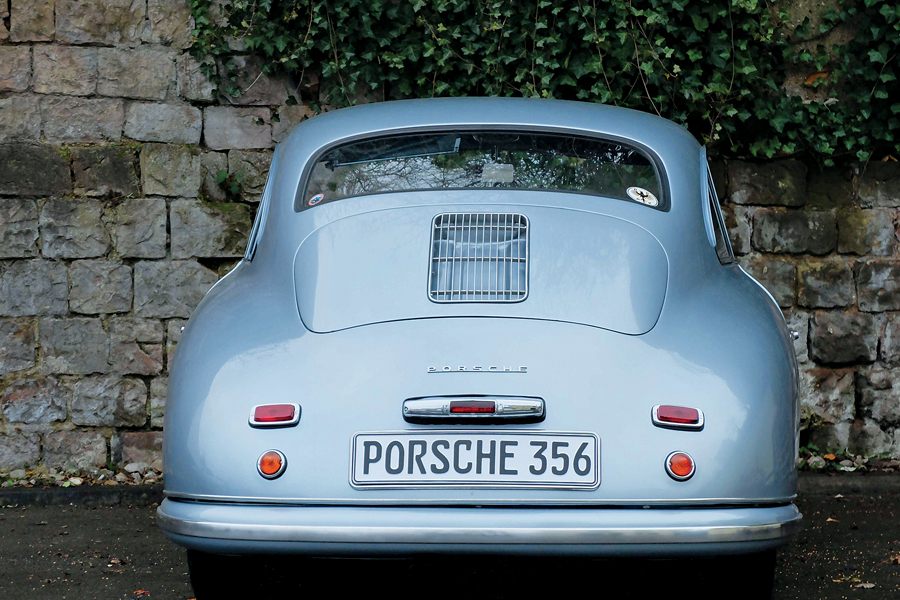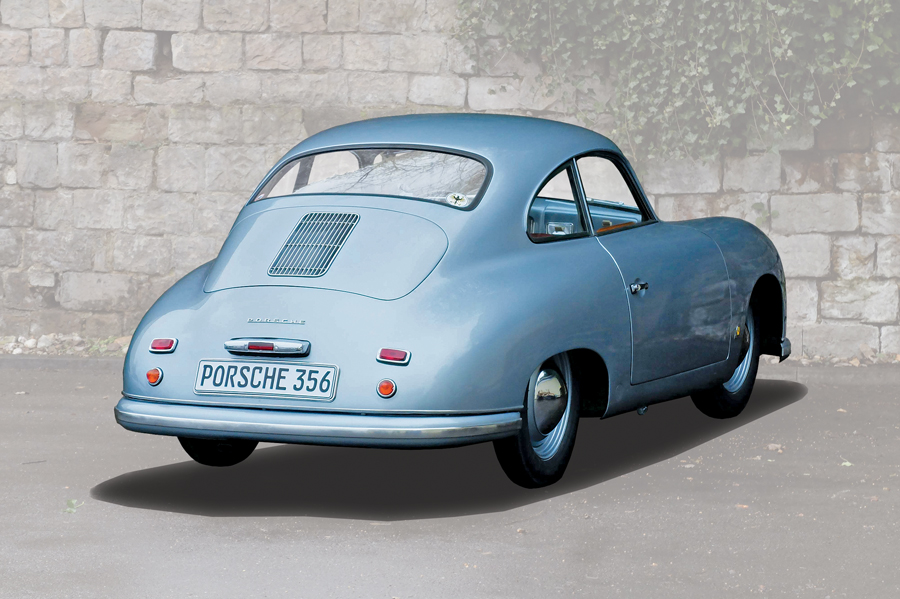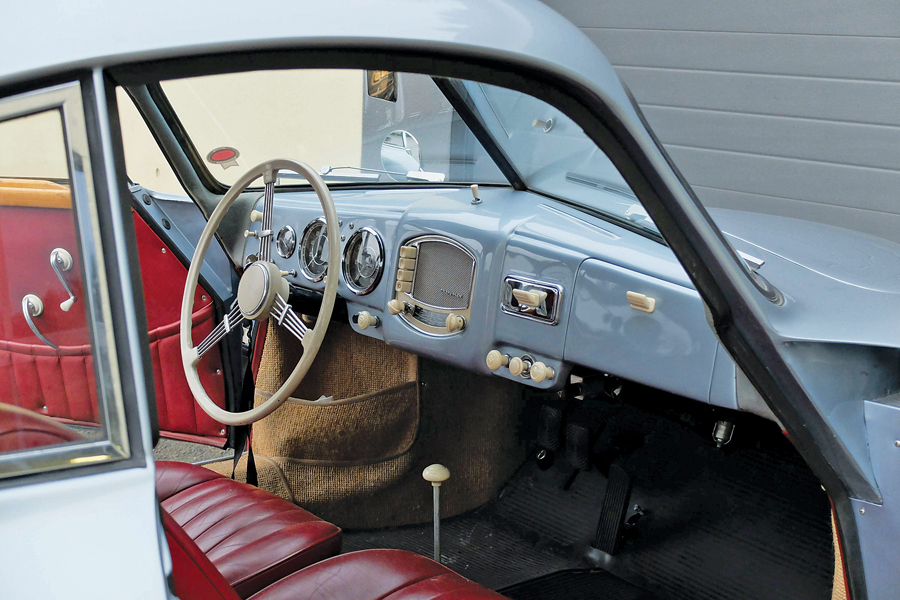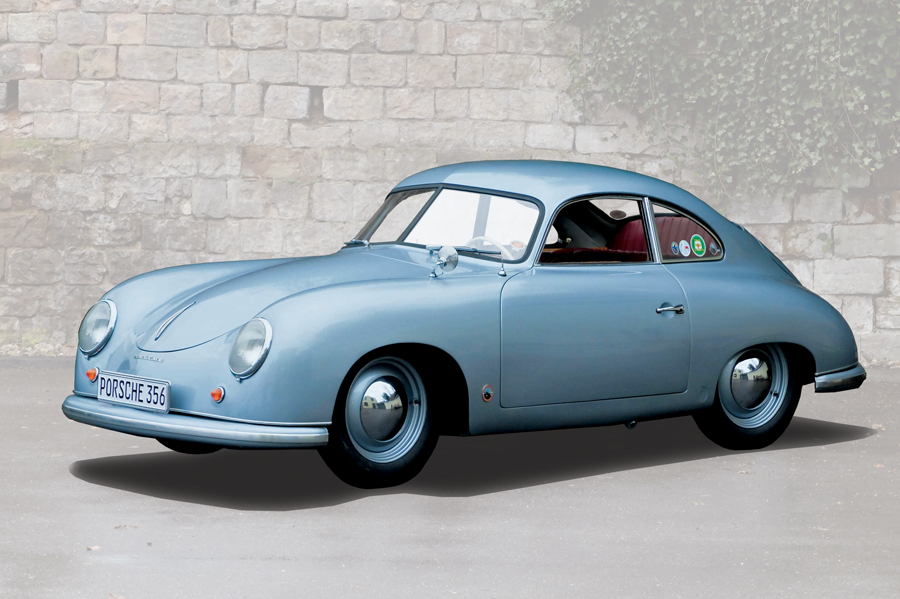SCM Analysis
Detailing
| Vehicle: | 1951 Porsche 356 Pre-A 1300 Coupe |
| Years Produced: | 1951 |
| Number Produced: | 1,238 |
| Original List Price: | Approximately $2,750 in Germany |
| SCM Valuation: | $224,000 |
| Tune Up Cost: | About $1,000 with plugs and valve adjustment |
| Chassis Number Location: | Stamping centered below gas tank in trunk, aluminum tag on passenger’s side of gas tank, Reutter tag on driver’s side A-pillar doorpost |
| Engine Number Location: | Upright support for the fan, passenger’s side |
| Club Info: | Porsche 356 Registry |
| Website: | http://www.porsche356registry.org |
| Alternatives: | 1951–54 Jaguar XK 120, 1951–58 Lancia Aurelia B20GT, 1951–54 Alfa Romeo 1900 |
| Investment Grade: | B |
This car, Lot 105, sold for $1,097,206, including buyer’s premium, at Artcurial’s Rétromobile sale in Paris, France, on February 9, 2018.
Early 356s are somewhat primitive cars by Porsche standards, and for years they were largely out of favor. Now more collectors want them, and competitive bidding has raised prices to levels not anticipated.
In 1950, Porsche reunited its staff in Stuttgart from their “headquarters-in-exile” in Gmund, Austria, where about half of the almost 600-man firm had been dispatched by the German government to avoid Allied bombing during World War II. Another large contingent had been in northern Germany constructing and managing the new Volkswagen factory, with others at two Porsche homes in Stuttgart and Zell am See (Austria), and a very small group at the firm’s former design headquarters in the Zuffenhausen section of Stuttgart.
VW royalties helped create Porsche cars
In 1949, VW started paying royalties to the Porsche firm for their design of the “Beetle.” Porsche also received rent from the American occupation forces that had taken over their Stuttgart building for a motor pool. With that money, Porsche decided to build cars.
Their first move was to commission 500 sets of 356 chassis and body panels from Reutter Karosserie. Porsche calculated that they could sell 100 cars a year. They rented 5,000-plus square feet of the Reutter plant for engine/gearbox and car assembly.
While the new facility was a huge improvement over the sawmill in Gmund, it was still a hand-assembly operation with skilled craftsmen. It was closer to carriage manufacturing than to any modern automobile plant. Furthermore, in those post-war years, raw materials were scarce and metallurgical advances were difficult.
An engineering reputation
What Porsche had to its advantage was superior engineering — albeit in a quirky design. With the post-war success of Volkswagen, thanks almost entirely to the occupation British Army’s management of the VW plant, Professor Porsche and his firm’s automobile designs were suddenly almost mainstream. VW made about 1,000 cars in 1945, 10,000 in 1946, and reached a cumulative 1,000,000 cars by 1954.
Porsche benefited from VW’s public acceptance, the VW dealer network — and from enthusiastic road testers who found Porsches to be very capable. Porsches were expensive, as they were priced higher than either Jaguar XK 120s or Cadillacs. By 1952, when U.S. Porsche sales began in earnest, a coupe’s base price was $4,200 on the East Coast and $4,350 on the West Coast.
Production in Stuttgart of the first steel-bodied 356s began in March 1950. The 52 earlier Gmund-built coupes were hand-shaped aluminum over wooden body bucks. Reutter and Porsche produced 392 cars in 1950, just over 1,200 in 1951 and grew to about 3,000 annually by 1955.
VW-based mechanicals — but more fully developed
The first 356s were developed off a VW mechanical base — with a more advanced tub and suspension. While performance was leisurely, handling was superior even with the trailing throttle oversteer.
The initial 1,086-cc Type 369 engine used a VW case with four main bearings, dual Solex carburetors, Porsche-designed heads with domed pistons for a 7.0:1 compression ratio and 40 horsepower. Porsche also used VW non-synchromesh 4-speed gearboxes, brakes and steering boxes, which were all earlier Porsche designs, of course.
For 1951, Porsche resolved some licensing issues with Lockheed and returned to the brakes that they had used in the Gmund-built cars, with two leading-edge brake shoes, now built by Ate in Germany. Porsche also replaced the rear-lever shocks with telescoping tubulars. Later in 1951, Porsche introduced a revised 1,286-cc engine with enlarged bores for the new Mahle cylinders made in finned aluminum — not un-ribbed steel — and with chromium liners. A new, quieter Eberspächer muffler was also fitted.
Race on Sunday and sell … afterwards
Early on Porsche knew the value of competition successes. Porsche always looked for venues where they could be successful, and the company promoted those wins.
A win in the 1,100-cc class at Le Mans in 1951 helped, as did class victories in numerous rallies and world records in speed trials.
Early 356s in the collector market
Gmund-built, aluminum-bodied Porsches and early Stuttgart-built steel-bodied 356s traditionally have been of interest mostly to Europeans. They saw much more of these cars back in the day, of course, having interactions with them through family, neighbors, dealers, races and rallies. Through the 1970s and 1980s, North Americans mostly ignored early 356s, with a few notable exceptions — and some of those were German expats.
In 1977, Automobile Quarterly’s iconic owner and publisher, Scott Bailey, published an 886-page, large-format book on Porsche written by a former journalist and automobile executive. Karl Ludvigsen’sPorsche: Excellence Was Expected was a huge hit with Porsche enthusiasts who became conversant with the marque’s history.
Ludvigsen was a trained engineer who read and spoke conversational and engineering German. He spent months at the Porsche factory interviewing workers and executives — and he had full access to the archives. With a detailed text that set a high bar for automotive research and with voluminous photographs from the archives, Porsche’s history came alive.*
Interest in all Porsches blossomed — including the very early ones.
An eye-popping result — but not the first
Now, let’s look at our subject Artcurial auction car. It was serial number 11101, of late 1951 production. The car’s Kardex (factory build card) shows it was delivered to a U.S. serviceman who reportedly took the car home to California. It stayed in the U.S. until about 1994, when it went back to Germany.
The car did suffer from numerous incorrect details, which is not unusual, as these early 356s are very idiosyncratic.
The car was built with a Type 506 1,286-cc engine, number 20774. That unit died early, which was not uncommon — remember the post-war metallurgical issues — and it was replaced with a later case with 1,488-cc pistons and cylinders to deliver an estimated 55 horsepower.
The car was recently repainted in its original Fish Silver Grey color, and the crash box was replaced with a later VW unit with synchros on the second through fourth gears. The original gearbox was included in the sale.
The car sold at Monterey 2017 was built 10 cars later
A well-known and well-shown black 1951 coupe, chassis 11111, sold at RM Sotheby’s Monterey auction in August for $1,017,500 — setting a world-record auction result (SCM# 6846361). That car presented very well in black paint over a green interior, and it had a matching-number engine, the desirable 1,488-cc Type 527 unit that was introduced in the fall of 1951.
This car also had numerous incorrect details. RM Sotheby’s had estimated the car at $500,000 to $600,000, and the owners had the car on the market for months beforehand for a reported $600,000. At the auction, two determined bidders made history.
Another world-record result
When this Fish Silver Grey example came to auction, Artcurial estimated it at $539,000 to $612,000. Once again, it took a couple of very determined bidders to raise the Monterey world-record result, but that they did — by about $77,000. The winner was reportedly a beloved, semi-retired American comedian with a large Porsche collection. And as he is prone to doing, he plans to drive it — not just pet it.
Do two $1 million-plus results make a market standard for 1951s? What will the more rare, more-desirable four-digit-serial-number cars from 1950 do at future auctions? These two huge auction sales results will undoubtedly bring more early 356s to market, so we will have opportunities to watch and learn. I believe that the RM Sotheby’s Monterey and Artcurial Paris results probably were outliers, but I am fully prepared to be wrong. ♦
* The newer edition of Excellence was Expected goes through 2002 in three volumes. It is available from Bentley Publishers and your favorite online bookseller. It’s the one Porsche title to take to your grave.
(Introductory description courtesy of Artcurial.)
